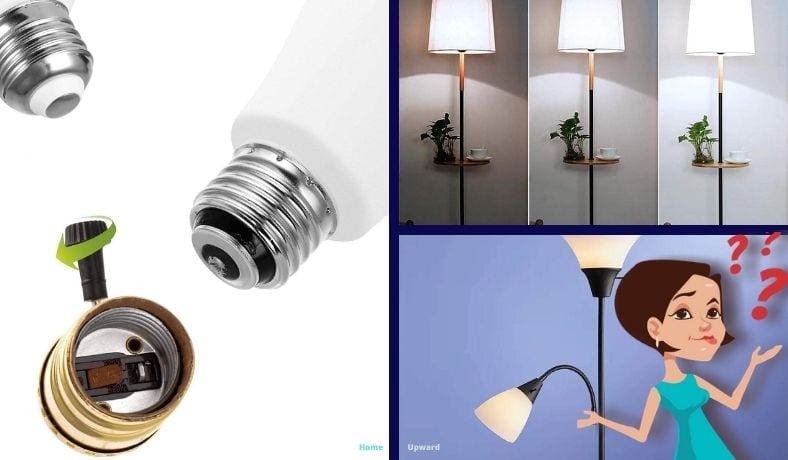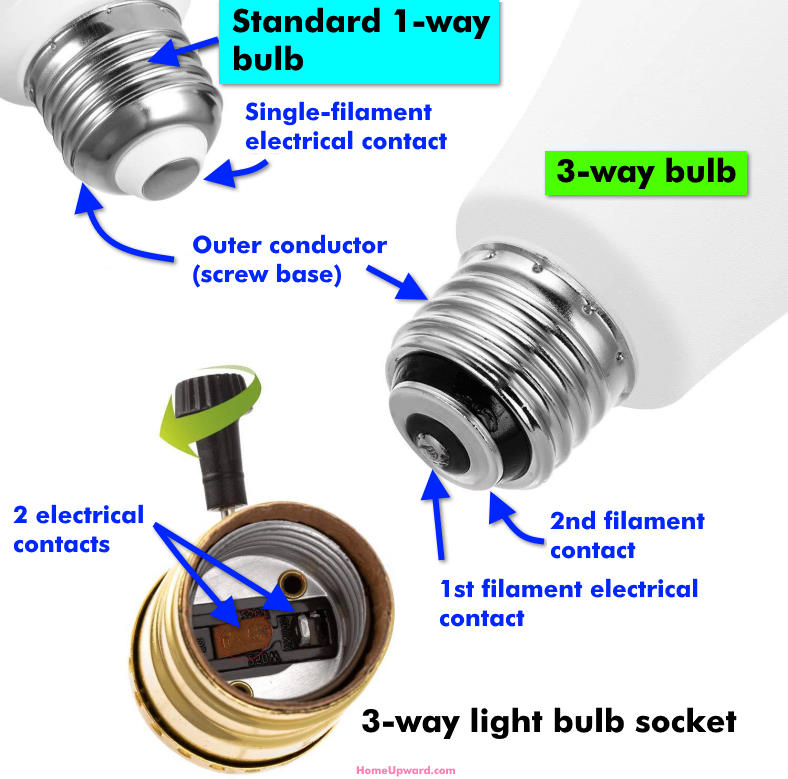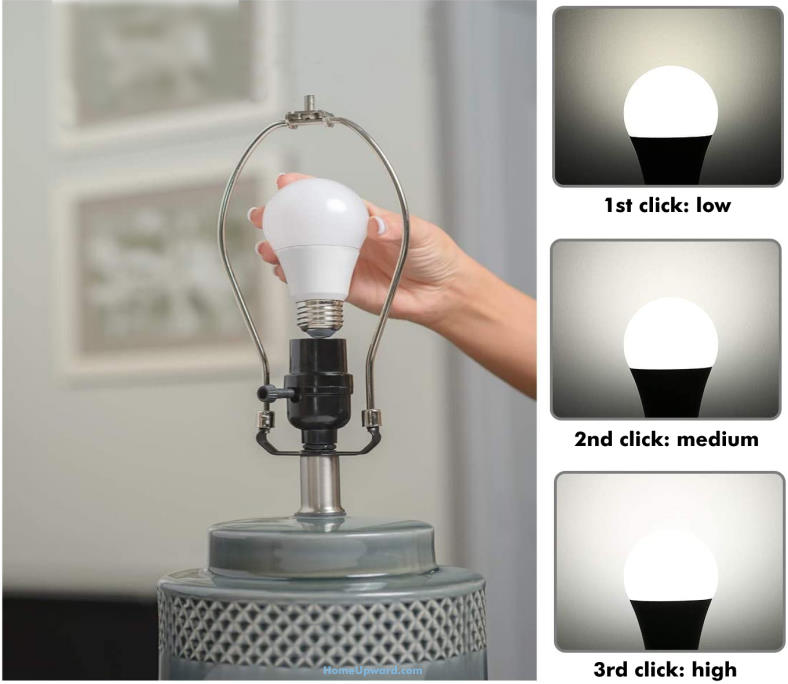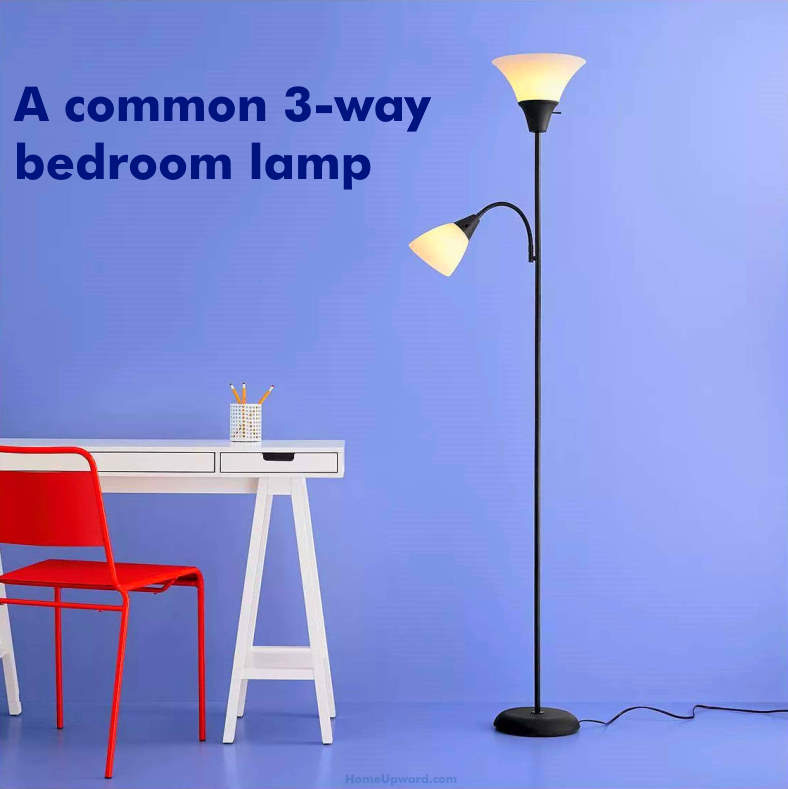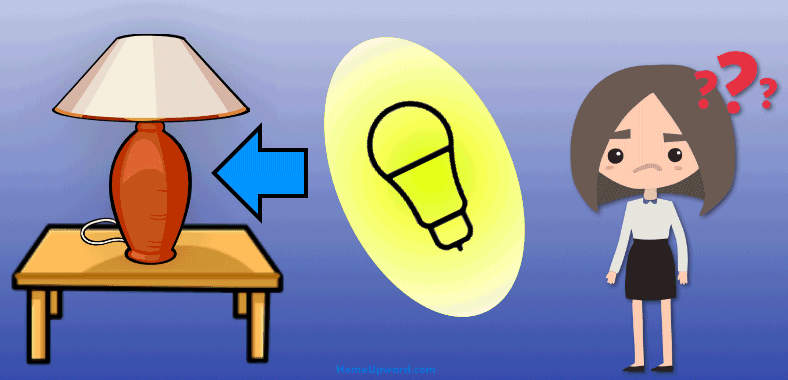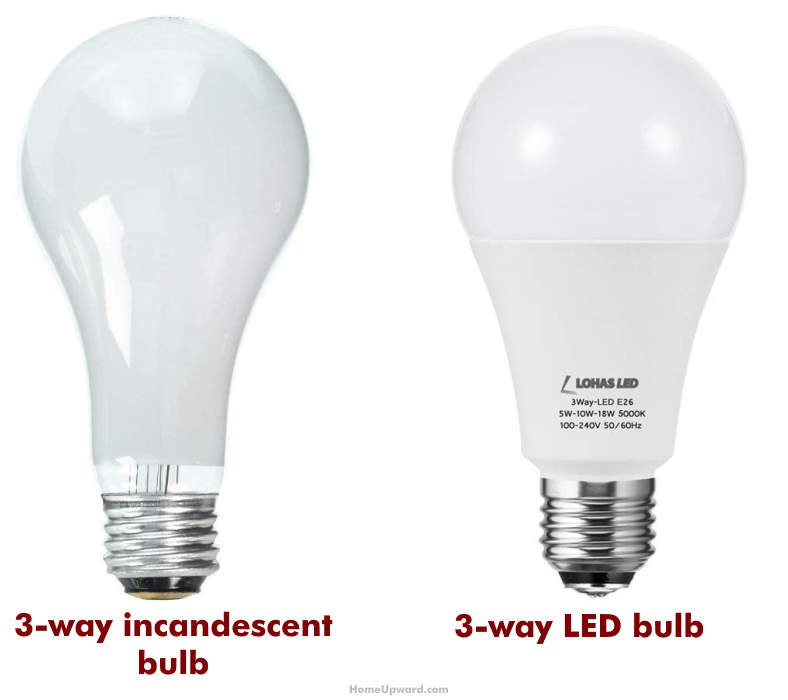You wouldn’t want a bright light when watching a movie or a dim light when trying to sew, would you? Different situations call for different lighting and a 3 way light bulb is the perfect solution to different lighting needs.
But what is a 3-way light bulb? Read on to learn everything you need to know about 3 way light bulbs and 3-way lamps.
Contents
What is a three way bulb?
Shown here is a diagram comparing a standard 1-way (single filament) bulb to a 3-way light bulb. Three-way bulbs have a 2nd electrical contact to power the 2nd filament for more lighting options in the same bulb size.
Three-way light bulbs are an extension of standard single-filament light bulbs. They offer three instead of only one level of light to choose from. Three-way bulbs need a matching socket in order to use the 3 light levels, however.
This means you’ll need to use lamps designed to work with 3-way bulbs in order to be able to select all 3 light brightness levels.
How do 3 way bulbs work?
While standard (1-way, single filament) bulbs work by simply using a single on or off setting and one light filament, 3-way bulbs offer 3 brightness settings and 3 power wattage/brightness options. These kinds of bulbs usually have listed power ratings like 30W/70W/100W or 50W/100W/150W.
You’ll notice that the third number in both instances is the total of the other two numbers added together.
Three way bulb sockets
These kinds of bulbs have exactly the same kind of screw-in base just like standard bulbs. Once the bulb is screwed into the base, one turn of the switch will illuminate just the low-brightness filament (usually a 30 or 50W filament). The second turn will switch on just the 70W or the 100W element.
When turning the switch a third time, both elements will work together to provide the brightest wattage of 100 or 150 depending on the bulb you bought.
What happens when I turn the switch?
All electrical switches work by connecting the circuit to the load and then disconnecting it again. When you turn the switch the first time on a 3 way bulb, the switch connects to a tab on the outer ring contact, which is the lower wattage part of the bulb. The light bulb then creates the low setting brightness output.
When you turn the switch a second time, it disconnects power from that electrical contact and connects to the center contact which is the higher wattage element (creating a medium brightness output).
When you turn the switch one more time, it connects power to both elements at the same time, which allows the bulb to create a high brightness output since both filaments are powered at the same time.
Finally, when you turn the switch one last time, power is disconnected from all sources and the light goes out.
What is a 3-way lamp?
Three-way lamps are simple household (or ceiling) lamps that use sockets compatible with 3-way bulbs instead of standard 1-way bulbs. They can be table lamps or very common floor lamps like the examples you see here.
A 3-way lamp is a lamp that has a socket and switch designed for 3 way light bulbs (not to be confused with 3-level brightness touch lamps). Most common sized lamps will take a standard E26, A19, or A21 3 way light bulb.
However, some floor lamps that have a bowl-shaped shade may take a PS25 bulb, which is larger. This is sometimes known as a Mogul screw base, or E39. The wattage of these bulbs is generally larger, using around 100/200/300 watts.
In addition to regular switches, there are also touch lamps that work as a 3-way lamp. The difference, in this case, is that the brightness is controlled by a special lamp driver circuit instead of switching between different bulb filaments.
Can you put a 3 way bulb in any lamp?
Yes, you can put a 3 way bulb in any lamp. Just know that only the higher wattage element will illuminate and the switch will function as a simple on and off switch.
This is because the higher wattage element is situated in the center point on the base, which will be utilized by the switch. For instance, if you’re using a 30/70/100W 3 way bulb, only the 70W element will illuminate when in a regular lamp.
Can you put a regular (1-way) light bulb in a three way lamp?
Yes, you sure can! Since the center electrical contact of a 3 way bulb is the same as the contact used by a regular bulb, it’ll work fine. Of course, this will only illuminate at the single wattage of the regular bulb.
Another drawback is that for one of the positions of the light switch the bulb will be turned off since it won’t have power when the 2nd electrical contact would normally be used.
That means you’ll have to rotate the 3-way bulb socket’s light switch more than you would a regular. Other than that, however, you can feel free to use a regular bulb if that’s all you have handy.
What if my 3 way bulb is not working correctly?
If your 3-way bulb isn’t working correctly, there could be a few things going on, these include:
- You may be using a standard bulb instead of a 3 way bulb.
- One of the elements of the 3 way bulb may be burnt out.
- The contact tab for the part of the lamp that feeds power to the lower wattage element may be damaged or has poor contact and needs to be repaired or cleaned.
- One or more of the light switch positions has failed and isn’t making electrical contact anymore.
To tell if it’s a problem with the bulb or the lamp, try a fresh 3 way light bulb just to see if that solves the problem. Then, you’ll know if the problem lies with the bulb or the lamp.
If your bulb is only turning on to 1 setting instead of 3 even with a fresh bulb, the problem likely lies in the lamp. Otherwise, an element in the bulb is probably burnt out. Also double-check the bulb to make sure it’s not a standard bulb.
Last (but not least), if you have a voltage test meter handy you can carefully measure voltage at the 2nd electrical contacts in the socket while connecting it to the neutral (screw base) metal section. The switch should provide 11oV to 120V for each of the “on” switch positions a bulb would use.
Is there a 3 way LED light bulb?
Yes, there are many choices for a 3 way LED light bulb. These bulbs may cost more initially, but they make up for that upfront cost by using less energy and lasting longer.
This type of bulb is also more environmentally friendly. LED 3-way bulbs are generally found in the same wattage configuration equivalents as conventional bulbs as well as in 40/60/100. However, even though these bulbs put out the equivalent of 40/60/100W in terms of light brightness, they only use 3.5/7/14.5 watts.
There are also choices for the type of light emitted such as soft white light, a cool light, a more traditional yellowish (2700K color), or bright white light to simulate natural sunlight (closer to 5000K color).
LED lights have the advantage of turning on brightly immediately, unlike CFL bulbs, which need to take time warming up. Another great side benefit of 3-way LED bulbs is that they produce a lot less heat than traditional incandescent bulbs.
Where can I buy 3 way light bulbs?
You can find 3 way light bulbs at pretty much any major retailer and you can often pick some up while at the grocery store or office supply store.
Grab some at a home improvement store, such as Lowe’s or Home Depot. Target and Walmart also have 3 way light bulbs for very competitive prices (under $10-$9 or so). Go to the store in person, or also consider ordering 3 way light bulbs online.
Online retailers such as Amazon have a wide selection as well as specialty stores such as Lighting Supply, Bulborama, or Bulbs.com.

